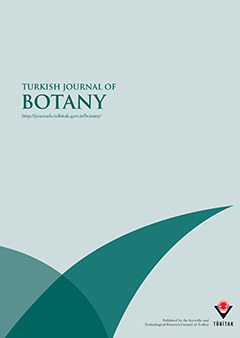Ver ítem
- xmlui.general.dspace_homeCentros e Institutos de InvestigaciónCIRN. Centro de Investigaciones de Recursos NaturalesInstituto de Recursos BiológicosArtículos científicosxmlui.ArtifactBrowser.ItemViewer.trail
- Inicio
- Centros e Institutos de Investigación
- CIRN. Centro de Investigaciones de Recursos Naturales
- Instituto de Recursos Biológicos
- Artículos científicos
- Ver ítem
Leaflet trichome micromorphology in the Dolentes-Brevipedes taxonomic complex (Mimosa L., Mimosoideae)
Resumen
We studied leaflets of 18 taxa of the genus Mimosa, specifically the Dolentes-Brevipedes taxonomic complex, focusing on micromorphology, type, shape, and density of trichomes. Within the nonglandular trichomes we described 3 types of nonbranched and 2 types of branched trichomes. We also described 2 types of stalked glandular trichomes, extending the recent classifications of trichomes in Mimosa. Multiseriate trichomes with lateral projections, which
[ver mas...]
We studied leaflets of 18 taxa of the genus Mimosa, specifically the Dolentes-Brevipedes taxonomic complex, focusing on micromorphology, type, shape, and density of trichomes. Within the nonglandular trichomes we described 3 types of nonbranched and 2 types of branched trichomes. We also described 2 types of stalked glandular trichomes, extending the recent classifications of trichomes in Mimosa. Multiseriate trichomes with lateral projections, which resemble incipient branching, are described here for many taxa. Most studied taxa have pubescent leaflets and show great variability in trichome density values. We also found 3 different types of blade margins with variation in type, alignment, and orientation of trichomes. Results show that the micromorphology of blade trichomes allows distinguishing groups of taxa in this complex, which could be a new tool for performing taxonomic treatment of both subseries.
[Cerrar]

Autor
Grohar, Mariana Cecilia;
Rosenfeldt, Sonia;
Morales, Matias;
Fuente
Turkish Journal of Botany 40 (1) : 45-58 (2016)
Fecha
2016
Editorial
Tubitak Scientific & Technical Research Council, Turquía
ISSN
1300-008X
1303-6106
1303-6106
Formato
pdf
Tipo de documento
artículo
Palabras Claves
Derechos de acceso
Abierto
 Excepto donde se diga explicitamente, este item se publica bajo la siguiente descripción: Creative Commons Attribution-NonCommercial-ShareAlike 2.5 Unported (CC BY-NC-SA 2.5)
Excepto donde se diga explicitamente, este item se publica bajo la siguiente descripción: Creative Commons Attribution-NonCommercial-ShareAlike 2.5 Unported (CC BY-NC-SA 2.5)


